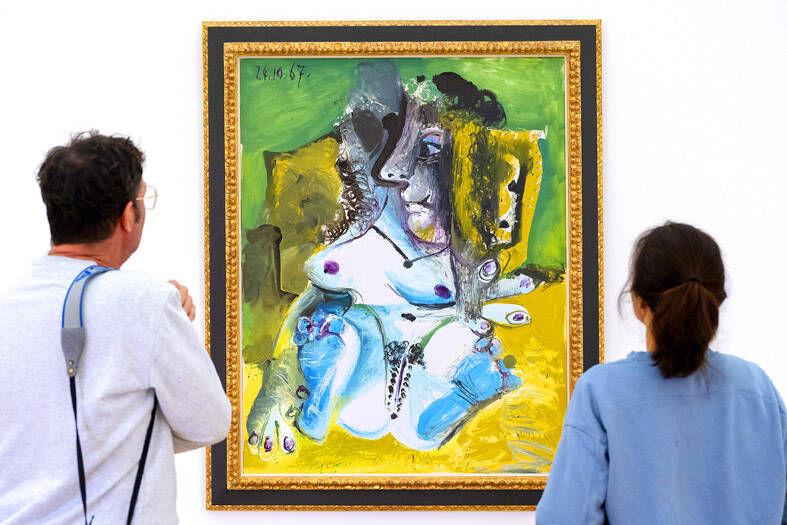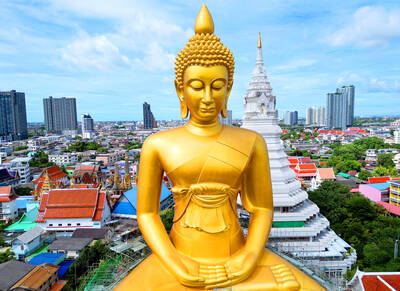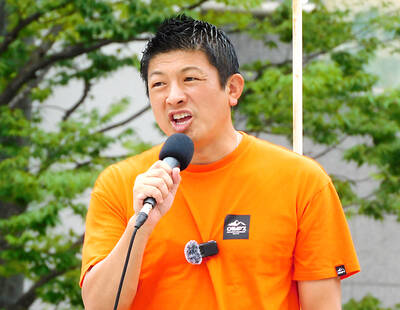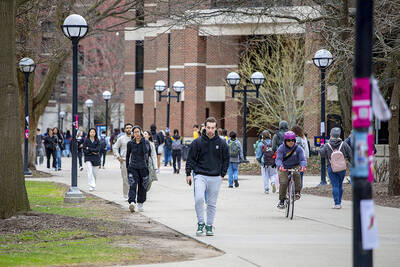On the 50th anniversary of Pablo Picasso’s death, it seems the appetite for the Spanish master remains inexhaustible.
Picasso’s ceramics, Picasso’s sculptures, Picasso and feminism, Picasso’s use of white, celebrity photographs of Picasso — the list of exhibitions marking the half-century since his death on April 8, 1973, runs on and on.
“Picasso gobbles everything up, and still we are hungry for more,” grandson Olivier Widmaier-Picasso said, adding that he was “fascinated by the number of curators, historians and researchers that continue to find new angles to explore.”

Photo: EPA-EFE
Explaining Picasso’s ubiquity is another matter.
The genius of his talent seems largely beyond dispute. His emergence at the start of the 20th century, just as the last obstacles to free expression were being dismantled, left him free to explore in every direction, and he simply never stopped, working from his teens right up to his death on the French Riviera at 91.
“He remains above everyone,” said Bernard Blistene, a former director of Centre Pompidou, a modern art museum in Paris.
“The permanent invention, the journey across all the great currents of modernity, the continuous experimentation for 80 years, the desire to please and displease ... all of it is without equal,” Blistene said.
The #MeToo movement has slightly rattled the elevated plinth on which Picasso’s reputation stands, as accusations that he was an abusive misogynist toward his wives and girlfriends trigger calls for a reappraisal.
“We must stop talking about the women in his life as ‘muses.’ Some committed suicide, others sank into madness,” said Emilie Bouvard, former curator at the Picasso Museum in Paris.
The exception was Francoise Gilot, the only mistress who dumped Picasso and lived to see 50 years pass since the death of “the tyrannical, superstitious and egotistical being” that she denounced in a famous book in the 1960s.
The damage has been limited. Picasso still regularly tops the list for highest-grossing artists at auction. His paintings generated US$494 million last year alone, Artprice data showed.
There is a balance to be found, Bouvard said.
“Picasso is someone who appropriated things, people,” she said.
His work often spoke of violence and sexuality — often with brutal, even courageous honesty — but he also turned those feelings on the women in his life.
“Dealing with this question means speaking differently, but fairly about Picasso,” Bouvard said.
That only opens up more ways to prime the pump of the Picasso industry. An exhibition at the Brooklyn Museum this summer, promising to re-evaluate the artist “through a feminist lens,” is being curated by comedian Hannah Gadsby, one of Picasso’s most outspoken critics.
Meanwhile, crowds are flocking to a much lighter retrospective at the Picasso Museum in Paris curated by fashion designer Paul Smith. It suggests that the sexual politics have done nothing to undermine the simple pleasure that comes from seeing Picasso’s work.
“I made it very decorative because the idea is that young school children and teenagers will come and see his work in a different light,” Smith said. “Many of us have already seen Picasso many times around the world, so we hope to show it in a new way.”

IDENTITY: A sex extortion scandal involving Thai monks has deeply shaken public trust in the clergy, with 11 monks implicated in financial misconduct Reverence for the saffron-robed Buddhist monkhood is deeply woven into Thai society, but a sex extortion scandal has besmirched the clergy and left the devout questioning their faith. Thai police this week arrested a woman accused of bedding at least 11 monks in breach of their vows of celibacy, before blackmailing them with thousands of secretly taken photos of their trysts. The monks are said to have paid nearly US$12 million, funneled out of their monasteries, funded by donations from laypeople hoping to increase their merit and prospects for reincarnation. The scandal provoked outrage over hypocrisy in the monkhood, concern that their status

The United States Federal Communications Commission said on Wednesday it plans to adopt rules to bar companies from connecting undersea submarine communication cables to the US that include Chinese technology or equipment. “We have seen submarine cable infrastructure threatened in recent years by foreign adversaries, like China,” FCC Chair Brendan Carr said in a statement. “We are therefore taking action here to guard our submarine cables against foreign adversary ownership, and access as well as cyber and physical threats.” The United States has for years expressed concerns about China’s role in handling network traffic and the potential for espionage. The U.S. has

A disillusioned Japanese electorate feeling the economic pinch goes to the polls today, as a right-wing party promoting a “Japanese first” agenda gains popularity, with fears over foreigners becoming a major election issue. Birthed on YouTube during the COVID-19 pandemic, spreading conspiracy theories about vaccinations and a cabal of global elites, the Sanseito Party has widened its appeal ahead of today’s upper house vote — railing against immigration and dragging rhetoric that was once confined to Japan’s political fringes into the mainstream. Polls show the party might only secure 10 to 15 of the 125 seats up for grabs, but it is

The US Department of Education on Tuesday said it opened a foreign funding investigation into the University of Michigan (UM) while alleging it found “inaccurate and incomplete disclosures” in a review of the university’s foreign reports, after two Chinese scientists linked to the school were separately charged with smuggling biological materials into the US. As part of the investigation, the department asked the university to share, within 30 days, tax records related to foreign funding, a list of foreign gifts, grants and contracts with any foreign source, and other documents, the department said in a statement and in a letter to